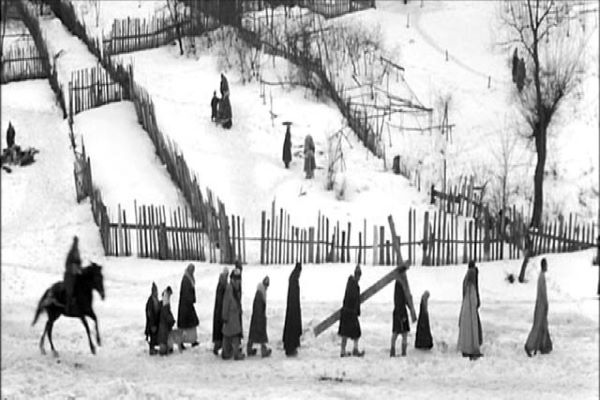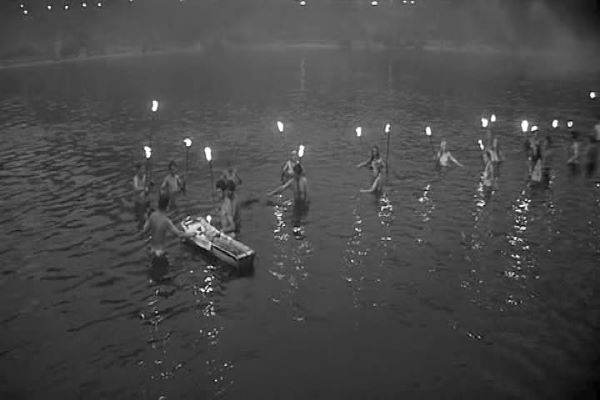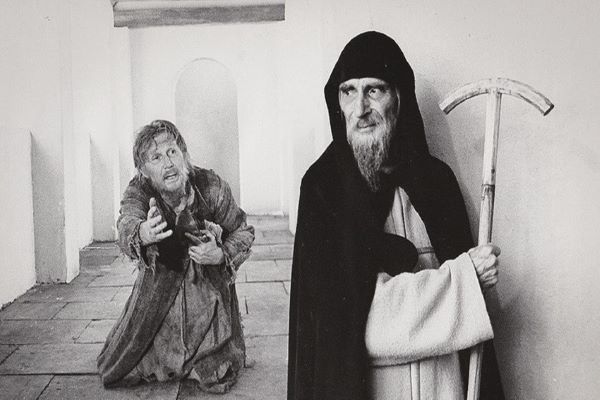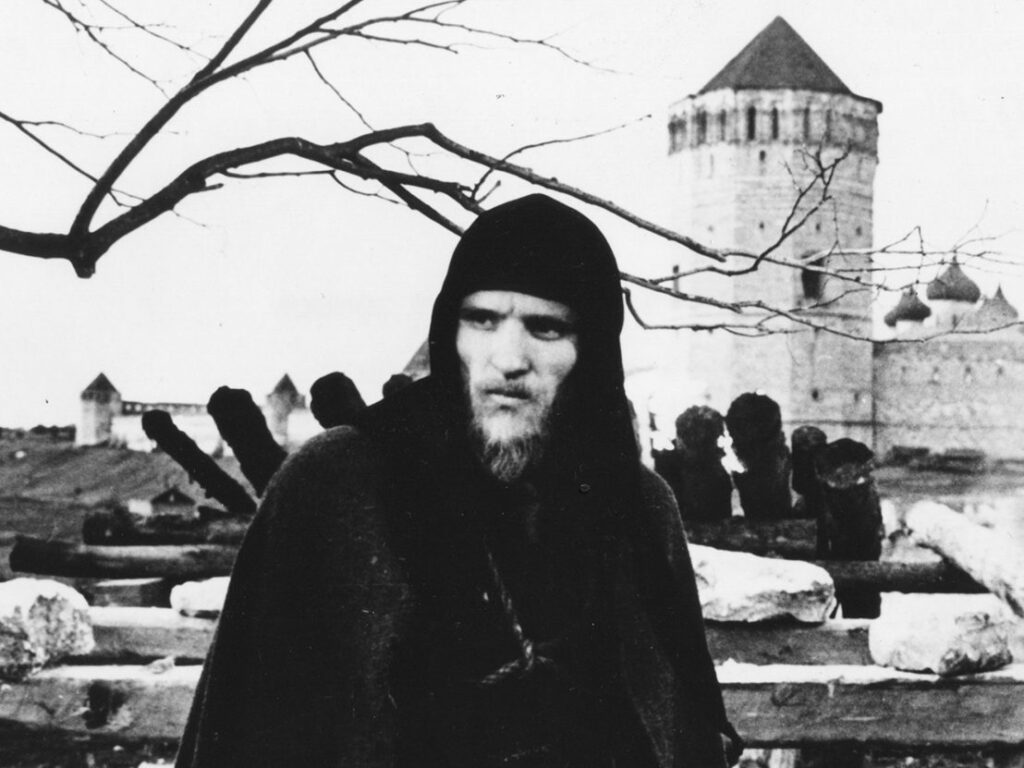Andrei Tarkovsky’s epic poetic and deeply religious film Andrei Rublev is a great character study of Russia’s greatest icon painter Andrei Rublev. However, Tarkovsky did not intend this to be a historical or biographical film. He wanted to unravel the life experiences of a great artist that inspired and shaped his art and artistic manifestations. Tarkovsky wanted to analyze the poetry of the timeless icons that he painted. The film shows medieval Russia from 1400 to 1424 and is divided into 8 episodes with a prologue and an epilogue. Andrei Rublev features multiple incidents of the early 15th century like Tatar invasions, Pagan rituals, rivalries amongst princes, etc. The film deals with atrocities like rape, raid, murder, betrayal, revenge, punishment. But, it also portrays love, peace, compassion, brotherhood, and deeply rooted Orthodox Christian faith.
Andrei Rublev starts with a prologue where a man named Yefim takes a flight on a gas balloon that crashes on the ground shortly killing him. This prologue shows the daring nature of humans who can even risk their lives for their passion. The rolling horse at the end of the prologue represents the hope that inspires us to keep moving forward in life.

In the 1st episode (Summer 1400), Andrei (Anatoly Solonitsyn), Daniil (Nikolai Grinko), and Kirill (Ivan Lapikov) leave Andronikov Monastery for Moscow. During a heavy downpour, they take shelter in a village barn where a jester or skomorokh is entertaining villagers by mocking at the state and the Church. After some time, the state soldiers arrive there, knock him unconscious, smash his musical instrument, and take him away.
In the 2nd episode (1405 – 1406), Kirill arrives at the workshop of the great painter Theophanes the Greek (Nikolai Sergeyev) where Kirill’s knowledge impresses him. He invites Kirill to decorate the Cathedral of the Annunciation in Moscow. Kirill refuses initially but accepts the offer only if Theophanes personally visits Andronikov Monastery and invites him in front of the other monks including Andrei Rublev. Shortly afterward, a messenger arrives at the Monastery and offers the job to Andrei instead of Kirill. This offer to Andrei agitates both Daniil and Kirill to a great extent. Daniil refuses to accompany Andrei to Moscow but wishes him good luck. However, Kirill can’t control his anger and leaves the Andronikov Monastery for a secular world. While walking off the snowy yard of the monastery, his dog starts following him, but he kills the dog beating it with his walking stick.
In the 3rd episode (The Passion – 1406), Andrei leaves for Moscow with his disciple Foma who lies sometimes and is not interested in seeking the deeper meaning of his work. They meet Theophanes the Greek in the forest where he only talks about negativities and pessimism in front of Andrei. He says that the Russian people are benighted because of their stupidity and people will again crucify Jesus if he takes birth again. Andrei despises him for his negative mentality and talks about love, peace, sympathy, and brotherhood. He even says that people who crucified Jesus were also following God’s orders.

In the 4th episode (The Holiday – 1408), Andrei witnesses Pagan rituals while collecting firewood in the forest and gets caught while spying on a couple making love. He is tied with a wooden beam in a hut with his hands raised upward. A pagan woman named Martha puts off her fur coat, kisses Andrei being naked, and unties him. In reply to Andrei’s harsh criticism of her religion, Martha argues that it is nothing but love. The next morning, a group of soldiers chases a few pagans on the riverbank. Martha’s lover is caught but she escapes swimming naked across the river passing just by the boat carrying a few monks including Andrei who look away in shame.
In the 5th episode (The Last Judgment – Summer 1408), Andrei and Daniil are decorating a church in Vladimir. But, Andrei loses inspiration to paint a terrifying and pessimistic subject like “The Last Judgment”. Foma leaves Andrei to paint smaller Churches. The grand duke is dissatisfied with the works of the artisans and orders them to paint the walls of his house as per his wish. However, the artisans already have the contract to paint the house of his brother. They proclaim that his brother’s house will look more beautiful than his house. This irritates the grand duke and his soldiers gauge out the eyes of the artisans making them blind. This terrifying act of revenge disappoints Andrei heavily and he throws paints on the walls of the church in anger. An innocent girl named Durochka (Irma Raush) is dissatisfied to see the haphazard paint on the walls. Her innocence inspires Andrei to paint a feast.
In the 6th episode (Raid – Autumn 1408), the younger brother of the grand duke forms an alliance with a group of Tatars and raids Vladimir. The town, as beautiful as a flower, is completely devastated by the atrocities of the invaders. Innocent civilians are killed, women are raped, buildings are set on fire, and Andrei’s paintings on the walls of the Church are completely destroyed. Andrei kills a man to save Durochka from getting raped by a Tatar. The magnificent town turns into a devastated land. The only two persons who remain alive are Andrei and Durochka. Andrei repents his crime and takes a vow of silence. The sudden massacre and atrocities make Durochka completely insane. She is seen tying the hair of a dead woman while snowflakes are falling down over the destroyed Church.

In the 7th episode (Silence – Winter 1412), Andrei lives in Andronikov Monastery but neither paints nor speaks. Durochka also lives there. The Tatars stop at the monastery while crossing through that area. They are impressed by Durochka’s innocence and play with her. Andrei tries to drag her away but fails as she is attracted to the horned helmet gifted to her by a Tatar who marries her as his 8th wife and takes her away. Kirill returns to the monastery and begs forgiveness from the father. The father pardons him on the condition of copying out the holy scriptures 15 times in penance. Kirill tries to make a conversation with Andrei but he does not reciprocate and remains silent.
In the 8th episode (1423 – 1424), A young boy named Boriska takes the onus to make a bronze church bell. He supervises the project of making the church bell including the selection of proper clay, pit location, the building of the mold, the firing of the furnaces, and the hoisting of the bell. He clarifies that his father secretly revealed the bell-making process to him. However, during the time of hoisting the bell for ringing, he has his self-doubts and can’t believe that the bell can be ringed. Helplessly, he starts crying and praying to God, which Andrei silently observes. When the bell finally rings, he breaks his vow and consoles Boriska that he has done a pretty good job. Andrei also says that from now onwards, they will work together; Boriska will cast bells and he will paint icons. During the bell hoisting ceremony, Durochka appears with her Tatar son and goes away when the bell finally rings.
Andrei Rublev has an epilogue section, which is the only part of the film in color, that shows the timeless iconic images painted by the great Russian painter like Enthroned Christ, Twelve Apostles, The Annunciation, Birth of Christ, The Trinity, etc. Tarkovsky differentiated Rublev’s life and his paintings through color. Great arts are always born out of utmost difficulties and sacrifices. The film ends with four horses standing in thunder and rain. Rain and horses in Tarkovsky’s films are recurring themes that signify hopes. In spite of all the atrocities, Andrei Rublev is a film about hopes, love, compassion, forgiveness, and brotherhood.
Andrei Rublev is a deeply religious film. Tarkovsky himself was a strong believer in Orthodox Christianity and the film is deeply inspired by that. Throughout the film, Anatoly Solonitsyn looks like Jesus Christ. Much like Christ, Andrei Rublev preaches love, compassion, forgiveness, and brotherhood. Tarkovsky presented Rublev like a replica of none other than Christ. Even though, the title of the film is the namesake of the great Russian painter, he does nothing heroic in the film. Viewers never see him painting; he takes a vow of silence and does not speak in the latter part of the film; in multiple scenes, he is not present at all. Tarkovsky wanted to dig his life deeper and analyze the poetry behind his classic icons. He did not intend this film to be a biographical or historical film. The basic purpose behind making this film was historical representation over historical accuracies. More than Rublev’s actions, the director was interested to portray his surroundings and associations. Tarkovsky wanted to highlight the life and culture of early 15th century Russia so that Rublev’s creations can be comprehended better. This is a rare poetic film wherein a great artist digs as much as possible into the life of another great artist.
Andrei Rublev features multiple iconic shots by cinematographer Vadim Yusov. The prologue section has some highly skilled overhead shots when the gas balloon takes a flight. Yusov’s camera efficiently captures the crude facets of violence on the screen almost throughout the film. It also captures the actions and emotions of Christ-like figure Andrei Rublev. Vyacheslav Ovchinnikov’s music resonates with the hardships of ordinary Russian citizens in the early 15th century. The remarkable background scores have been used in the scenes of Pagan rituals, Christ’s crucifixion, and the Tatar raid. Soviet authorities barred Andrei Rublev to be screened in the competition at the Cannes Film Festival. However, it was screened out of competition at the 1969 Cannes Film Festival where it won the FIPRESCI Prize. It is constantly ranked amongst the most important films ever made.
